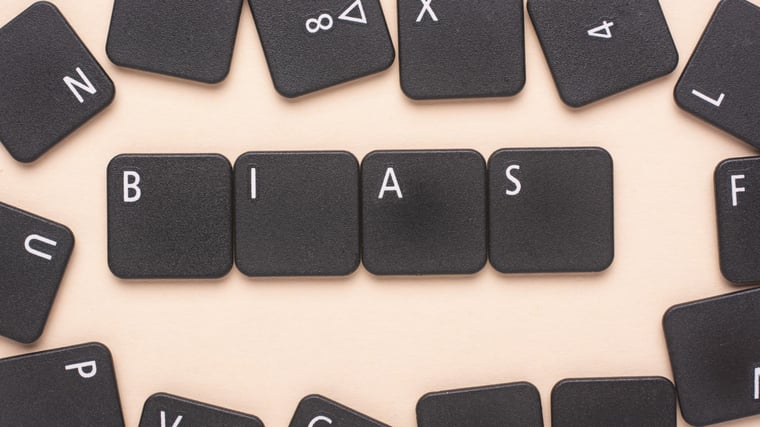“Wow, you’re so well-spoken”
“Can I touch your hair?”
“You’re the VP!?”
Bias can manifest in many ways in the workplace. Frequently, it will show up via microaggressions: small actions, words, attitudes, gestures and expressions that imply someone is an outsider or lesser-than.
Unlike macroaggressions, which are overt and obvious, microaggressions are subtle, and often unintentional. They accumulate, creating a workplace that feels exhausting and hostile for targets. Like more blatant expressions of bias, microaggressions usually impact people from marginalized groups the most.
Let’s look at an example. Individuals from marginalized ethnicities, religions, or cultures often experience microaggressions related to their name, family history, or appearance. Let’s say you’re part of a UK-based company, and have an employee called Haniya. Microaggressions around her name may appear as:
- pronouncing and spelling her name incorrectly
- joking that you’ll just have to call her Hannah, because it’s easier to remember and pronounce
- avoiding saying her name altogether
- asking many times how to pronounce her name, rather than making the effort to simply pronounce it correctly
For Haniya, each of these feels like a small pinprick; an implication that her name isn’t worth learning; that she’s an outsider; that she’s different. You may not be intentionally hurting her, but she is being impacted despite those intentions.
The experience of the target
Consider another example. Imagine Haniya is leading a small technical team of developers. Haniya and two others from her team are giving a virtual presentation to company leadership. As everyone joins the call, a leader from another division of the company, John, who is white, takes the opportunity to ask a few questions before the meeting begins. He directs his questions at Steve, a white man on the technical team who reports to Haniya.
Pause the scene. Steve is in fact the most junior team member, but John is assuming he’s the team lead, and unintentionally ignores the actual team lead, Haniya, who is a woman of color.
Being treated as more junior or less skilled than appropriate is a common microaggression for people who do not fit the stereotype of a leader, especially women. This is one way that the “prototype” bias manifests. While Steve’s skill is assumed, Haniya must demonstrate her skill many times to be taken seriously. This bias also shows up as:
- phrases of surprise that one holds a prestigious or technical role (I had no idea that you were the team lead!)
- mainly speaking to or making eye contact with others who demographically fit the stereotype of a leader (Steve in this example)
- using nicknames, while referring to other leaders using their titles
How might it feel for Haniya? She may feel frustrated and disrespected. She may be debating whether or not she wants to correct John, and whether this action is worth the risk and effort.
She may also feel exhausted. While this instance on its own may seem small, it’s something Haniya faces frequently. People who regularly experience microaggressions sometimes refer to them as “mosquito bites” or “paper cuts.” One may not be so bad, but being stung or cut over and over adds up, draining valuable energy and creating a lack of psychological safety.
The experience of the perpetrator
In this scenario, John is the perpetrator. From his perspective, he did not mean to exclude or disrespect Haniya. Despite those intentions, his rushed decision to direct questions to Steve harmed Haniya.
Usually, people have no idea they are perpetrating a microaggression in the workplace or in general. Instead, it either goes by completely unnoticed, or perhaps feels like a moment or two of awkwardness or slight embarrassment. This lack of need to see past one's intent and acknowledge that one is causing harm is one huge way that privilege shows up. What feels like nothing to the perpetrator is actively hurting the target, but perpetrators are usually not asked to confront the negative outcomes of their actions.
In his rush, John did not take the time to think through how his words or actions impacted others. He relied on stereotypes, rather than asking who was the lead or doing his own research ahead of time.
The experience of the bystander
Steve, the junior developer, was one bystander on this call. When the questions were directed at him rather than his boss Haniya, he felt uncomfortable and was unsure how to handle the situation. Others on the call were also bystanders.
To bystanders, microaggressions may appear as a minor comment or action that just doesn’t sit right or has a subtle undertone of disrespect. You may notice that you feel uncomfortable. You may also observe that the target appears tense, deflects, strikes back, withdraws, or uses another protective behavior. Or, they may show no outwards signs of discomfort.
It’s often easier to identify microaggressions as a bystander, rather than when we are perpetuating them.
How to handle microaggressions
When a microaggression occurs and the perpetrator is not aware of their misstep, allies and targets have three choices: let it go, deal with it now, or deal with it later.
When deciding, consider that there is always risk when pushing back. Targets should take care of themselves first; every risk may not be worth it. Allies should consider whether they can take on some of that risk themselves, especially if they hold more privilege.
Derald Sue and Nadhum Awad in their article Disarming Racial Microaggressions: Microintervention strategies for targets, white allies, and bystanders describe three ways to handle microaggressions.
- Make the microaggression visible. After all, if you can’t see it, you can’t fix it. This may look like a simple comment stating what happened. In our earlier example, perhaps a bystander could state, “John, I noticed you’re directing your questions to Steve. I’m guessing you assumed he’s the team lead, but Haniya is the lead.” This approach helps raise awareness for the perpetrator and bystanders.
- “Disarm” the microaggression. This goes a bit further, where the harm is stopped by deflecting, interrupting, or challenging the microaggression. An interruption might look like Haniya or a bystander saying, “John, we have a lot on the agenda today, so let’s save those questions for later.” A challenge might look like someone pulling John aside privately after the meeting, and informing him how making assumptions about roles is harmful.
- Seek support: “Targets, allies, and bystanders oftentimes put themselves at risk by confronting others about their microaggressions, and such efforts are often emotionally draining...advocates must also be prepared for the huge pushback likely to occur from others around them” (Sue & Awad 2019, p. 139). You may find support from a leader or an employee resource group within the organization. Or, you may need to look externally for support groups, counseling, or affinity groups.
Preventing microaggressions
The best way to handle a microaggression is to prevent it from happening at all. This responsibility falls first on the perpetrators. Keep in mind, we all have the potential to perpetuate microaggressions, since we all hold bias.
First, do your homework. Learn about bias, and the ways it emerges at work. Invest in understanding perspectives that are different from yours. This could be through news articles, documentaries, microlearning, books, podcasts, and so on. Reflect on your own behavior along the way.
Second, be aware of conditions where microaggressions are likely to occur. Common “risk areas” include:
- Rushing without thinking how we’re impacting others. This can cause you to rely on stereotypes and perpetuate bias.
- Making assumptions about skill level or job type.
- Participating in strong cliques or hierarchies at work. You’re less likely to understand the perspectives and experiences of those outside of your circle.
- Making “compliments” that imply the subject is an exception compared to others like them, or that focus on fixed traits (hair, accent, name, etc). For example, “You’re so well-spoken!” implies that you did not think they would be well-spoken. “Your hair is so exotic” carries the undertone of “you don’t fit in.”
Finally, if you realize that did perpetuate a microaggression, it is your responsibility to stop, apologize, and repair the harm.
Prevention should also take place at an organizational level. Each of these steps can be implemented more broadly. They will be particularly effective if top leadership participates and validates the process.
It’s important to remember that microaggressions in the workplace are a symptom of larger inequities. While they can (and should) be addressed individually, this must be done in parallel with larger-scale changes working towards a more equitable and inclusive workplace.




